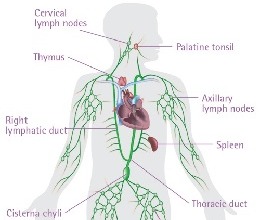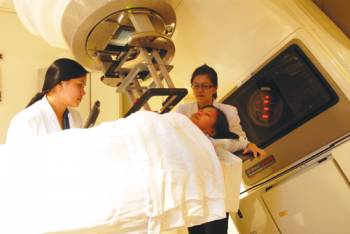Non-Hodgkin Lymphoma
 Lymphoma is a type of blood cancer that begins from lymphocytes in the lymphatic system. There are 2 main types of lymphomas, the Non-Hodgkin’s Lymphoma and Hodgkin’s Lymphoma. The Non-Hodgkin’s Lymphoma group can be divided into T & B Cell Lymphoma. The B Cell Lymphomas can be further subdivided into low grade of high grade Lymphoma.
Lymphoma is a type of blood cancer that begins from lymphocytes in the lymphatic system. There are 2 main types of lymphomas, the Non-Hodgkin’s Lymphoma and Hodgkin’s Lymphoma. The Non-Hodgkin’s Lymphoma group can be divided into T & B Cell Lymphoma. The B Cell Lymphomas can be further subdivided into low grade of high grade Lymphoma.
What Causes It?
It is often difficult to find a precise cause for most patients with Non-Hodgkin’s Lymphoma. However, several factors are known to be associated with the development of lymphoma. These factors include viruses like HIV (Human Immunodeficiency Virus), Epstein Barr Virus (EBV), HTLV-1 and HHV-8. Other possible factors include environmental carcinogens and certain genetic disorders like Wiskott–Aldrich Syndrome.
Signs and Symptoms
While Non-Hodgkin’s Lymphomas can present with a large variety of symptoms, the common symptoms are:
• Prolonged and recurrent fevers
• Unexplained weight loss
• Swollen lymph glands
• Night sweats
• Loss of appetite
Most often, these symptoms are not due to cancer. Other health problems can cause some of these symptoms. Anyone with such symptoms should see a doctor to be diagnosed and treated as early as possible.
Diagnosis & Assessment
How is Diagnosis Made?
|
A biopsy of the affected lymph glands is essential for the diagnosis of Non-Hodgkin’s Lymphoma. This can be in the form of an excision biopsy (removal of one entire lymph node) or a fine needle aspiration biopsy (where a needle is inserted into the affected lymph gland to draw cells out for examination). Special immunostains can be also performed to determine the precise subtype of Non-Hodgkin’s Lymphoma. |
StagingOnce the diagnosis of NHL is confirmed, a staging assessment has to be done. Staging refers to the extent of the lymphoma in the body. This often carries great prognostic significance and is very useful to help develop treatment plans for the patient. There are 4 stages (Stage I to IV) as well as a A or B category. The various stages are as follows: |
Treatment & Care
Treatment may involve any of the following modalities, chemotherapy, radiotherapy, biological therapy and stem cell transplant. Very often, it is likely a combination of 2 or more of the above modalities. This is dependent on the subtype of lymphoma and various prognostic features of the lymphoma.
Biological TherapyPeople with certain types of non-Hodgkin's lymphoma may have biological therapy to boost the immune system to fight cancer effectively. |
Stem Cell TransplantationA person with recurrent lymphoma may receive stem cell transplantation. A transplant of blood-forming stem cell allows a person to receive high doses of chemotherapy, radiation therapy, or both. The high doses destroy both lymphoma cells and healthy blood cells in the bone marrow. Later, the patient receives healthy blood-forming stem cells through a flexible tube placed in a large vein in the neck or chest area. New blood cells develop from the transplanted stem cells. |
Chemotherapy
|
Chemotherapy drugs are also known as cytotoxics. They kill cancer cells but may also kill some normal cells, such as the blood cells. As such, complications like anaemia and susceptibility to infections may result. In particular, opportunistic infections and life-threatening infections during the low white blood cell period are always feared. |
Radiation TherapyRadiation therapy (also called radiotherapy) uses high-energy rays to kill non-Hodgkin's lymphoma cells. It can shrink tumors and help control pain. Two types of radiation therapy are used for people with lymphoma: External radiation: A large machine aims the rays at the part of the body where lymphoma cells have collected. This is local therapy because it affects cells in the treated area only. Most people go to a hospital or clinic for treatment 5 days a week for several weeks. Systemic radiation: Some people with lymphoma receive an injection of radioactive material that travels throughout the body. The radioactive material is bound to antibodies that target and destroy lymphoma cells. |
|
What kind of support is available?
 CanHOPE, is a non-profit cancer counselling & support service initiated by Parkway Cancer Centre.
CanHOPE, is a non-profit cancer counselling & support service initiated by Parkway Cancer Centre.
As part of the holistic approach towards cancer treatment, CanHOPE works closely with the medical & allied health professionals, offering a wide range of resources & information about cancer in helping patients & their caregivers to make effective, informed decisions in their treatment journey.
Join us in our support programmes that are available on a monthly basis.
CALL our CanHOPE counsellors: +65 67389333 or e-mail:
Non-Hodgkin Lymphoma originally appeared on Parkway Cancer Centre and has been republished with permission
Further Reading
The article above is meant to provide general information and does not replace a doctor's consultation.
Please see your doctor for professional advice.



